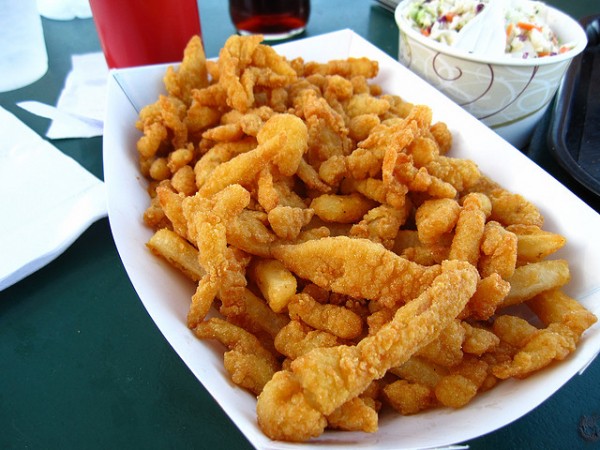
Perhaps a recent Onion headline sums it up best: “Taco Bell’s New Green Menu Takes No Ingredients From Nature.” Americans have never been famous for eating right. We’re unceremonious about dining, dependent on unhealthy foodstuffs, and obese about the middle. But do we eat worse than people in other countries? In advance of the Zócalo event “Is Eating Well Just For the Rich?,” we asked two Americans who do manage to eat natural ingredients for some thoughts on how Americans dine today.
U.S. immigration is our national strength–and our culinary weakness
 “You know how we can tell Americans don’t care about food?” my Lebanese Arabic teacher Manal asked me, laughing. “You have such tiny kitchens!” In Lebanon, she said with pride, the kitchen is the biggest room in the house–and only an idiot would rent an apartment with a so-called “American kitchen.” In my travels, both in the developed world and in developing countries, I’ve encountered this sad truth: not only does much of the rest of the world eat better than we do; it even mocks our misfortune.
“You know how we can tell Americans don’t care about food?” my Lebanese Arabic teacher Manal asked me, laughing. “You have such tiny kitchens!” In Lebanon, she said with pride, the kitchen is the biggest room in the house–and only an idiot would rent an apartment with a so-called “American kitchen.” In my travels, both in the developed world and in developing countries, I’ve encountered this sad truth: not only does much of the rest of the world eat better than we do; it even mocks our misfortune.
Of course, Mediterranean cultures like Lebanon, with their millennia of food traditions, are perhaps an unfair comparison for a newer nation like ours. But even in the Netherlands, hardly known as a nation of foodies, the Dutch at least have as sensible an approach to eating as they do to everything else: cheese sandwiches, fresh herring, and biking to balance out the French fries. Even when dinner isn’t delicious, it’s always a welcome social event.
Why is America’s food system so disastrous, our culinary knowledge so feeble? Our country’s greatest strength is its hard-working immigrants and geographical diversity–but, for food culture, that’s a weakness. The work ethic that built our country doesn’t leave time for a leisurely dinner, so food becomes simply fuel. Immigrants often work here without the support of family, and food traditions can fade in the course of assimilation. Immigration to America’s varied landscapes has produced regional specialties like Creole gumbo and New Mexican green chile enchiladas, but we still have no national food language. We struggle along in the pidgin of Hamburgerese.
Many Americans have bigger kitchens than Manal realizes–I brought her up to speed on granite countertops and Viking ranges. The next step is to relearn the world that can be created in those kitchens–then proudly call it American, and teach it to others.
Zora O’Neill is a guidebook writer and co-author of the cookbook Forking Fantastic! She is working on a book about Arabic language and travel in the Middle East.
————————————-
Our food habits are bad–but there’s hope
 In my opinion, Americans eat worse than people in many developed countries. We no longer value gathering around the table with family and friends. We see an emphasis on eating quickly and on the go. With this kind of disrespect for the meal, it is no wonder that people are not as concerned about the quality of the food. Reverence for the social and cultural values of breaking bread is what prompted journalist Carlo Petrini’s protest in Italy. In 1986 when McDonald’s fast food chain was planning to open a franchise in Rome on the Spanish Steps, an 18th century landmark, Petrini and a group of protesters gathered with bowls of pasta and other cooked dishes instead of picket signs. This simple act of defiance spawned the Slow Food Movement, which now boasts 100,000 members in 150 countries. The Slow Food chapters are called convivial–a name that calls to mind a place where people enjoy themselves over food.
In my opinion, Americans eat worse than people in many developed countries. We no longer value gathering around the table with family and friends. We see an emphasis on eating quickly and on the go. With this kind of disrespect for the meal, it is no wonder that people are not as concerned about the quality of the food. Reverence for the social and cultural values of breaking bread is what prompted journalist Carlo Petrini’s protest in Italy. In 1986 when McDonald’s fast food chain was planning to open a franchise in Rome on the Spanish Steps, an 18th century landmark, Petrini and a group of protesters gathered with bowls of pasta and other cooked dishes instead of picket signs. This simple act of defiance spawned the Slow Food Movement, which now boasts 100,000 members in 150 countries. The Slow Food chapters are called convivial–a name that calls to mind a place where people enjoy themselves over food.
But improving the way Americans eat is not as simple as restoring the family dinner around the table. Over the past 40 years food production, processing, and distribution in the U.S. have grown to an almost unimaginable scale, rewarding size and speed foremost. The subsidies in the U.S. Farm Bill have made fruits and vegetables more expensive. And most Americans live where there is little access to full-service grocery stores or farmers markets. Big-box stores reduce prices so much that smaller food stores cannot compete.
Fortunately, there is an increasing awareness of obstacles to good food. People are growing their own, shopping at farmers markets, relearning cooking skills, making better procurement choices. The tighter economy is reversing the trend of eating meals away from home. With education and civic engagement there is hope that our food future will be better than our food present.
Cheryl Danley is an outreach specialist and a Kellogg Foundation Food and Community Fellow with IATP. Trained in Food and Resource Economics, she currently works with the Center for Regional Food Systems at Michigan State University.
*Photo courtesy of Accidental Hedonist.



